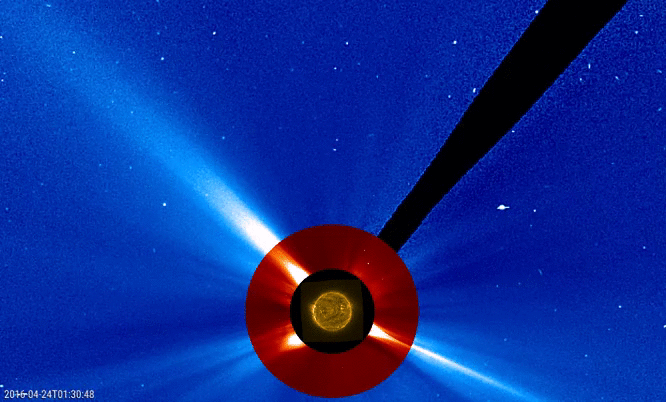As discussed during last week's news item, big sunspot group NOAA 2529 was a relatively quiet region before producing an M6 flare early on 18 April. The coronal mass ejection (CME) associated with this "medium" flare was not directed to Earth. The image underneath combines an extreme ultraviolet (EUV) picture (SDO/AIA 304) of the flare close to maximum intensity at 00:25UT, and a coronagraphic image (SOHO/LASCO C2) an hour later at 01:25UT showing the ejection of the particle cloud.

The departure of NOAA 2529 two days later was observed in many solar parameters as the related values quickly dropped to their nominal (low) levels. Two such parameters are the solar radio flux and the solar x-ray background flux, of which data can be found in the weekly SIDC bulletins.
Measurements of the 10.7 cm (2800 MHz) solar radio flux are made by the Dominion Radio Astrophysical Observatory (DRAO) at Penticton (Canada) at local noon (around 20:00UT). The reported values are expressed in solar flux units (sfu) and are not corrected for the variable Sun-Earth distance or any flaring or other eruptive activity.
The x-ray background flux is measured daily in the 0.1 to 0.8 nm range by the GOES spacecraft. It usually is a midday minimum given in terms of the x-ray flare class. There are 5 such classes (A, B, C, M, X), with each class being 10 times stronger than the previous one. A is the weakest class, and C ("common"), M ("medium") and X ("eXtreme", the strongest class) are mostly used for flares.
More info on both parameters can be found in NOAA/SWPC's User Guide.
The figure underneath shows the evolution of the solar radio flux (RFL; blue) and the x-ray background flux (XBG; red; note the logarithmic scale!) from 4 till 24 April. The presence of NOAA 2529 can readily be deduced from the enhanced radio and x-ray flux. Interestingly, XBG is already enhanced at least a day before the appearance of NOAA 2529, and remained so a day after its rounding the west limb (see the gray bars on 6 and 20 April). The extra enhancement is much less pronounced in the solar radio flux.

NOAA 2529 is currently transiting the solar backside. It still shows signs of occasionally vigorous activity. A good example of such a strong event occured just a few days ago, when on 24 April a partial halo CME became visible in SOHO/LASCO coronagraphic imagery. There was no sign of ongoing activity on the earth-facing solar disk, and STEREO-A imagery from the Sun's backside left no doubt that NOAA 2529 was the culprit. Between 02:00 and 06:00UT, a filament can be seen ejected mainly to the north of this "old" active region. It was associated with a coronal dimming and post-eruption coronal loops. This short movie first shows the CME as observed by SOHO/LASCO, and is followed by STEREO-A clips in EUV and coronagraphic observations. It's going to be very interesting to see how active NOAA 2529 still is when it will reappear from behind the east limb around 3-4 May.


 |
 |





